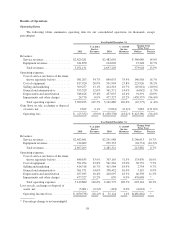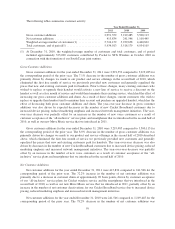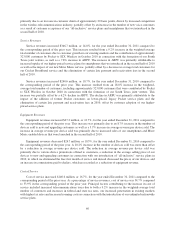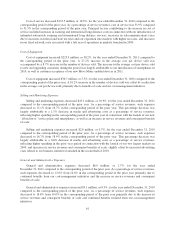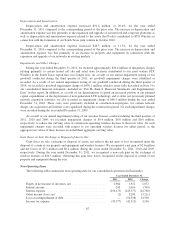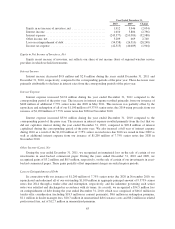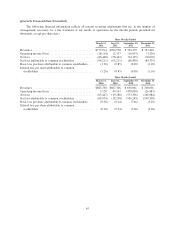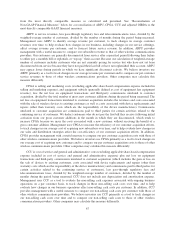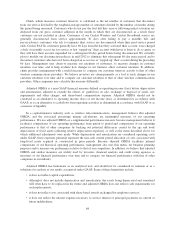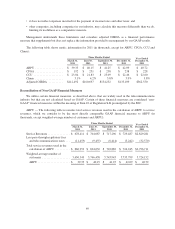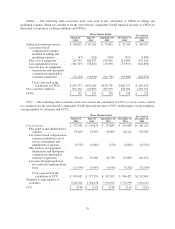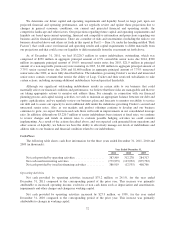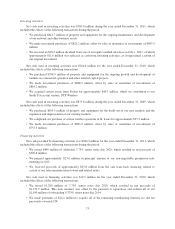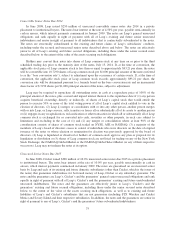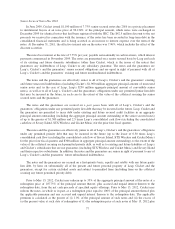Cricket Wireless 2011 Annual Report Download - page 78
Download and view the complete annual report
Please find page 78 of the 2011 Cricket Wireless annual report below. You can navigate through the pages in the report by either clicking on the pages listed below, or by using the keyword search tool below to find specific information within the annual report.Churn, which measures customer turnover, is calculated as the net number of customers that disconnect
from our service divided by the weighted-average number of customers divided by the number of months during
the period being measured. Customers who do not pay the first bill they receive following initial activation are
deducted from our gross customer additions in the month in which they are disconnected; as a result, these
customers are not included in churn. Customers of our Cricket Wireless and Cricket Broadband service are
generally disconnected from service approximately 30 days after failing to pay a monthly bill, and
pay-in-advance customers who ask to terminate their service are disconnected when their paid service period
ends. Cricket PAYGo customers generally have 60 days from the date they activated their account, were charged
a daily or monthly access fee for service or last “topped-up” their account (whichever is later) to do so again, or
they will have their account suspended for a subsequent 60-day period before being disconnected. We currently
plan to modify our disconnection policies in mid-2012 to eliminate this subsequent 60-day grace period and to
disconnect customers who have not been charged an access fee or “topped-up” their account during the preceding
60 days. Management uses churn to measure our retention of customers, to measure changes in customer
retention over time, and to help evaluate how changes in our business affect customer retention. In addition,
churn provides management with a useful measure to compare our customer turnover activity to that of other
wireless communications providers. We believe investors use churn primarily as a tool to track changes in our
customer retention over time and to compare our customer retention to that of other wireless communications
providers. Other companies may calculate this measure differently.
Adjusted OIBDA is a non-GAAP financial measure defined as operating income (loss) before depreciation
and amortization, adjusted to exclude the effects of: gain/(loss) on sale, exchange or disposal of assets, net;
impairments and other charges; and share-based compensation expense. Adjusted OIBDA should not be
construed as an alternative to operating income (loss) or net income (loss) as determined in accordance with
GAAP, or as an alternative to cash flows from operating activities as determined in accordance with GAAP or as
a measure of liquidity.
In a capital-intensive industry such as wireless telecommunications, management believes that adjusted
OIBDA, and the associated percentage margin calculations, are meaningful measures of our operating
performance. We use adjusted OIBDA as a supplemental performance measure because management believes it
facilitates comparisons of our operating performance from period to period and comparisons of our operating
performance to that of other companies by backing out potential differences caused by the age and book
depreciation of fixed assets (affecting relative depreciation expenses) as well as the items described above for
which additional adjustments were made. While depreciation and amortization are considered operating costs
under GAAP, these expenses primarily represent the non-cash current period allocation of costs associated with
long-lived assets acquired or constructed in prior periods. Because adjusted OIBDA facilitates internal
comparisons of our historical operating performance, management also uses this metric for business planning
purposes and to measure our performance relative to that of our competitors. In addition, we believe that adjusted
OIBDA and similar measures are widely used by investors, financial analysts and credit rating agencies as
measures of our financial performance over time and to compare our financial performance with that of other
companies in our industry.
Adjusted OIBDA has limitations as an analytical tool, and should not be considered in isolation or as a
substitute for analysis of our results as reported under GAAP. Some of these limitations include:
• it does not reflect capital expenditures;
• although it does not include depreciation and amortization, the assets being depreciated and amortized
will often have to be replaced in the future and adjusted OIBDA does not reflect cash requirements for
such replacements;
• it does not reflect costs associated with share-based awards exchanged for employee services;
• it does not reflect the interest expense necessary to service interest or principal payments on current or
future indebtedness;
68


